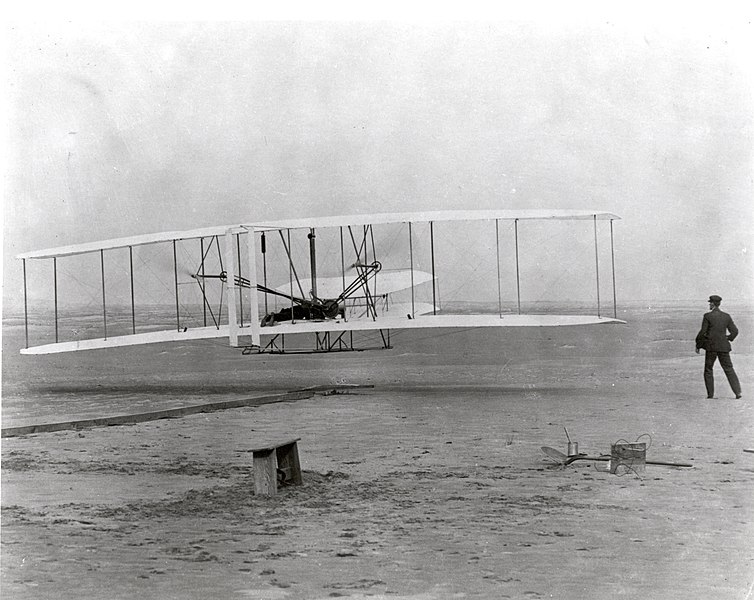File:The Wright Brothers First Heavier-than-air Flight - GPN-2002-000128.jpg

Original file (1,639 × 1,304 pixels, file size: 1.13 MB, MIME type: image/jpeg)
Captions
Captions
| DescriptionThe Wright Brothers First Heavier-than-air Flight - GPN-2002-000128.jpg |
English: On December 17, 1903, at 10:30 am at Kitty Hawk, North Carolina, this airplane arose for a few seconds to make the first powered, heavier-than-air controlled flight in history. The first flight lasted 12 seconds and flew a distance of 120 feet. Orville Wright piloted the historic flight while his brother, Wilbur, observed. The brothers took three other flights that day, each flight lasting longer than the other with the final flight going a distance of 852 feet in 59 seconds. This flight was the culmination of a number of years of research on gliders. Orville and Wilbur Wright's curiosity with flight began in 1878 when their father, Milton, gave them a rubber band powered toy helicopter. Although they were never formally educated, the self-taught engineers constantly experimented with kites and gliders. Bicycle shop owners by occupation, the brothers spent years designing, testing and redesigning their gliders and planes. After the successful flights of December 17, 1903, Orville and Wilbur continued to perfect their plane. In 1909 the Army Signal Corps purchased a Wright Flyer, creating the first military airplane. Although Wilbur passed away May 30, 1912, from typhoid fever, Orville remained an active promoter of aviation until his death on January 30, 1948. The Air Age truly began with that historic flight on December 17, 1903. In 1908 the Wright Brothers designed the first military aircraft for the Army Signal Corps. Seven years later, in 1915, the National Advisory Committee for Aeronautics (NACA) became the nations leading aviation research organization, of which Orville was a member for 28 years. As the airplane became more aerodynamic and technically advanced, its uses expanded into many different directions. Military aircraft played significant roles in both World War I and World War II. The airplane made worldwide travel and exploration possible. Spaceflight would never have been realized without the pioneering achievements of the Wright Brothers. |
||||||||||||||||
| Date | |||||||||||||||||
| Source | Great Images in NASA Description | ||||||||||||||||
| Author |
creator QS:P170,Q6259960 |
||||||||||||||||
| Permission (Reusing this file) |
|
||||||||||||||||
| Other versions |
|
||||||||||||||||
This image or video was catalogued by NASA Headquarters of the United States National Aeronautics and Space Administration (NASA) under Photo ID: GPN-2002-000128 and Alternate ID: 65-H-611. This tag does not indicate the copyright status of the attached work. A normal copyright tag is still required. See Commons:Licensing. Other languages:
العربية ∙ беларуская (тарашкевіца) ∙ български ∙ català ∙ čeština ∙ dansk ∙ Deutsch ∙ English ∙ español ∙ فارسی ∙ français ∙ galego ∙ magyar ∙ հայերեն ∙ Bahasa Indonesia ∙ italiano ∙ 日本語 ∙ македонски ∙ മലയാളം ∙ Nederlands ∙ polski ∙ português ∙ русский ∙ sicilianu ∙ slovenščina ∙ Türkçe ∙ українська ∙ 简体中文 ∙ 繁體中文 ∙ +/− |
File history
Click on a date/time to view the file as it appeared at that time.
| Date/Time | Thumbnail | Dimensions | User | Comment | |
|---|---|---|---|---|---|
| current | 22:59, 9 April 2009 |  | 1,639 × 1,304 (1.13 MB) | BotMultichillT (talk | contribs) | {{Information |Description={{en|1=On December 17, 1903, at 10:30 am at Kitty Hawk, North Carolina, this airplane arose for a few seconds to make the first powered, heavier-than-air controlled flight in history. The first flight lasted 12 seconds and flew |
You cannot overwrite this file.
File usage on Commons
There are no pages that use this file.
File usage on other wikis
The following other wikis use this file:
- Usage on fi.wikipedia.org
- Usage on fr.wiktionary.org
- Usage on pt.wikipedia.org
- Usage on si.wikipedia.org
Metadata
This file contains additional information such as Exif metadata which may have been added by the digital camera, scanner, or software program used to create or digitize it. If the file has been modified from its original state, some details such as the timestamp may not fully reflect those of the original file. The timestamp is only as accurate as the clock in the camera, and it may be completely wrong.
| _error | 0 |
|---|




